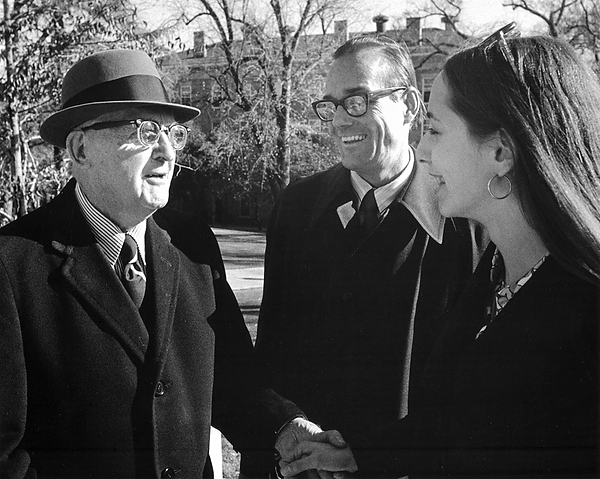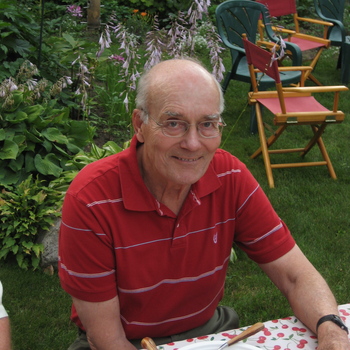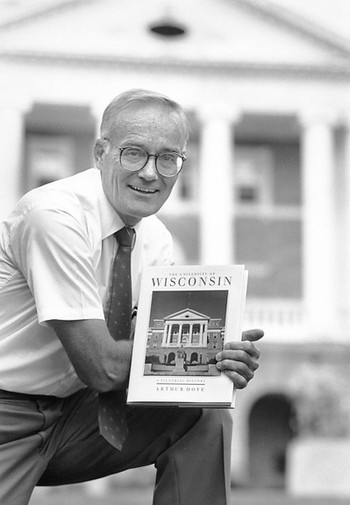Art Hove’s legacy lives on across campus

Arthur Hove, center, looks on as president emeritus E.B Fred meets with undergraduate and senior class vice president Barbara Lee Kornblau on Bascom Hill at the University of Wisconsin–Madison in November 1976.
Photo: Norman Lenburg/UW-Madison
Arthur O. Hove II didn’t just love UW–Madison; he lived UW–Madison.
Before he became a trusted advisor to multiple University of Wisconsin chancellors, Hove studied with Helen C. White and Ronald Mitchell. In 1962, when UW President Conrad Elvehjem suffered a fatal heart attack in his office, Hove lifted the stretcher.
“Everyone I used to know is now a building or a street,” Hove said in a 2012 profile.
Hove, who died last week at 80, was so eager to come to the UW that he applied as a high school sophomore. He ended up playing a role in seven decades of the university’s history.

Art Hove died last week at age 80.
Photo courtesy of the Hove family
“Art knew everybody, and everybody knew Art,” says Paul Williams, emeritus professor of plant pathology and a friend for many years. “It wasn’t just Bascom Hall — it was the shop guys, the plumber, the electrician.”
Hove began his administrative ascent in the 1960s, as many new hires formed the core of what became the academic staff.
“A group of us used to meet in the Union calling ourselves the Angry Young Administrators Association,” recalls Joe Corry, associate vice chancellor emeritus. “We were all trying to figure out how the university worked.”
Between reaction to campus unrest (including the Sterling Hall bombing in 1970) and the retirement of UW President Fred Harvey Harrington, who laid the groundwork for the university’s transition into the UW System, few people could predict the university’s path through the late 1960s and early 1970s.
Hove took advantage of informal gatherings to discuss what was going on, defusing the tension with legendarily bad puns. These actions set the tone for his career: stepping back for perspective while bringing factions together.

Hove with his pictorial history book about the University of Wisconsin–Madison in front of Bascom Hall in September 1991.
Photo: Jeff Miller/UW-Madison
“Art was both the ‘oil’ and the ‘glue’ — sort of a paradoxical juxtaposition,” says Williams. “When a professor or dean or chancellor needed to know what an outcome should be, he could help them chart a course, because he knew more of the components of this complex institution than anyone else. That was the oil. But he could show you how to stick things together and keep things working. That was the glue.”
One good way to stay abreast of the chancellor’s work: travel everywhere together. Edwin Young, chancellor from 1968-1977, had poor vision, so Hove became both his driver and confidant. Later on, Irving Shain — chancellor from 1977-1986 — would drop Hove off at his Nakoma home each night.
“He and I developed a very close friendship,” says Shain. “These conversations were very valuable to me because it broadened my perspective on the university and my role in it.”
But Hove’s instincts didn’t always hit home. Asked to help Shain address a faculty luncheon, Hove’s notecards read, “I know nothing about the physical sciences, but I do know this much: if you put vinegar and baking soda in a bottle, and cork it rapidly, that cork will fly all the way across campus.”
Shain was not impressed. He stood up in the luncheon, looked at his cards, then tore them up with a nod to “this fellow in my office who writes speeches.”
“By the time I got back to my office,” Shain recalls, “15 or 20 friends had called Art to warn him that I was on a rampage and was going to cause him a lot of trouble.”
Hove’s campus legacy begins with strong friendships. For 40 years, he was central to a noon running group that continues today. Many deep discussions about the state of the university took place while tramping through Shorewood Hills, or in a locker room at the Natatorium.
“His love for the university was enormous. Many of us took an important lesson from Art in noting how important the institution was to him. That was more important than anything else, I think.”
Irving Shain
Originally placed on a Picnic Point light pole in 1996, “Art’s Plaque,” a gift from the group, now sits on a rock near the shore. Hove’s bronze signature is burnished by the runners who touch it every day before turning back.
“I’ve seen many people telling other people about the plaque,” says Williams. “It probably gets more attention than Lincoln’s knee.”
In retirement, Hove turned his considerable knowledge of the university into several published works. In particular, “The University of Wisconsin: A Pictorial History” became a great resource for information seekers.
“He made some really important contributions in those books,” says Shain. “His love for the university was enormous. Many of us took an important lesson from Art in noting how important the institution was to him. That was more important than anything else, I think.”
One of Hove’s most lasting contributions stemmed from his addiction to diet soda. Every other week, Hove delivered a black garbage can full of two-liter bottles to Williams’ driveway.
These bottles became the basis for the internationally known Bottle Biology program. Within the small, inexpensive plastic containers, young science students can create an ecosystem, explore the concept of niche, and model a lakeshore.
Hove’s bottles have found homes in children’s museums across the country. Teaching manuals in seven languages demonstrate their use. There’s even a Bottle Biology club in the Aldo Leopold residence hall on campus.
Even Hove’s most unexpected contributions made an unforgettable impact.
“Art was my continuing supply of two-liter bottles for a 25-year period,” says Williams, a wry note in his voice. “Now my supply is cut off. I don’t know what to do.”
Tags: campus administration, history, obituaries



